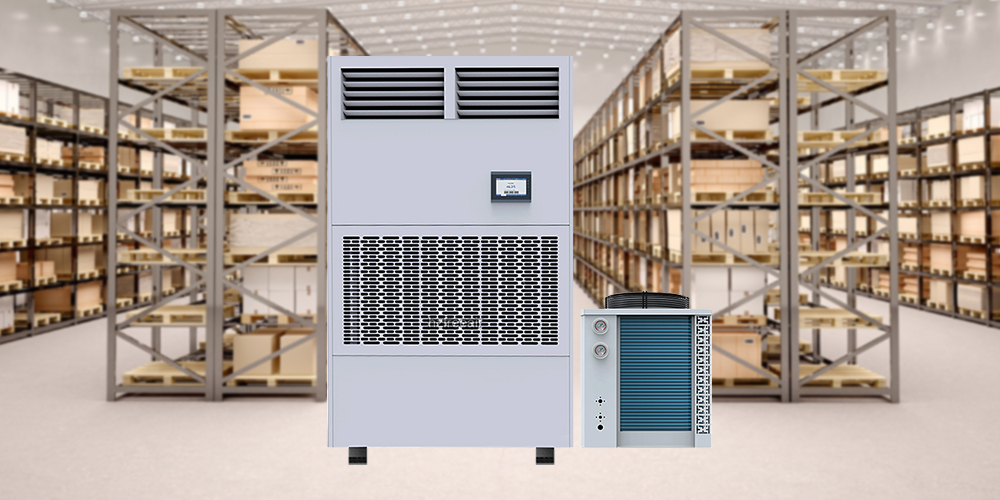


In industrial production, humidity control is a key factor affecting product quality, equipment lifespan, and energy efficiency. Traditional
industrial dehumidifiers often rely solely on a single dehumidification technology. However, industrial dehumidifiers with cooling functions,
thanks to their advantages such as high efficiency, energy saving, precise humidity control, and strong adaptability, are becoming the preferred
solution for modern factories, warehouses, laboratories, and other places. This article will deeply explore the core advantages of cooling-type
industrial dehumidifiers, their applicable scenarios, and how to choose the most suitable model (dehumidification capacity 168-1200L/D) based
on your needs, helping you make the best decision!
Cooling + Dehumidification in One System, Four Core Advantages
1. High Efficiency and Energy Saving, Reducing Operating Costs
Traditional rotary dehumidifiers rely on electric heating for regeneration, resulting in extremely high energy consumption;
while the model that combines refrigeration dehumidification and intelligent cooling works together, using the refrigeration
system to rapidly condense moisture, significantly reducing energy consumption.
2. Large Dehumidification Capacity, Stable Operation (168 - 1200L/D)
Suitable for medium and large industrial environments, such as:
168 - 300L/D: Small and medium-sized workshops, food processing plants
300 - 600L/D: Electronic factories, lithium battery production workshops
600 - 1200L/D: Large warehouses, pharmaceutical factories, chemical industries
Refrigeration dehumidifiers can operate stably in high-temperature and high-humidity environments (30℃ - 40℃, RH 80%+),
avoiding the problem of traditional dehumidifiers' efficiency decline in extreme conditions.
3. Precise Humidity Control, Ensuring Production Quality
Humidity adjustable range: 30% - 80% RH, meeting the needs of different industries (such as lithium battery production requiring ≤ 20% RH).
Intelligent constant humidity system, automatically adjusts operation mode, avoiding excessive dehumidification or humidity fluctuations that affect production.
4. Strong Adaptability, Can Be Used in Harsh Environments
Low-temperature environment (5℃ - 15℃): Some models are equipped with low-temperature dehumidification mode to avoid frosting affecting efficiency.
High dust, corrosive environment: Optional explosion-proof, anti-corrosion models are available, suitable for chemical, electroplating industries, etc.

Applicable scenarios: Which industries require refrigerated industrial dehumidifiers the most?
Industry | Humidity requirements | Recommended dehumidification capacity (L/D) | Key Requirements |
Lithium battery production | ≤20% RH | 300-1200 | Explosion-proof, precise humidity control |
Food processing | 40%-60% RH | 168-600 | Mold prevention, energy saving |
Pharmaceutical/ electronic workshops | 30%-50% RH | 300-800 | Dust-free, constant humidity |
How to choose the appropriate industrial dehumidifier? (168 - 1200 L/D)
1. Determine the required dehumidification volume
Calculation formula: Dehumidification volume (L/D) = Space volume (m³) × Target humidity reduction value × Environmental coefficient
Reference values:
Ordinary workshop (500 square meters, with a ceiling height of 3 meters) → 300 - 500 liters per day
Large warehouse (500 square meters, with a ceiling height of 6 meters) → 800 - 1200 liters per day
2. Selecting the Cooling Method
Type | Applicable scenarios | Advantages&Disadvantages |
Freezing dehumidification (standard) | Normal temperature& high humidity environment (20℃ - 35℃) | Energy-saving, but not suitable |
Low-temperature dehumidification | 5℃ - 15℃ cold storage, cold chain | Anti-frosting, but with slightly |
Mixed dehumidification | Extremely low humidity requirement (≤ 20% RH) | Precise humidity control, |
3. Intelligent Control and Maintenance Convenience
Remote monitoring (via APP/cloud) facilitates management.
Automatic drainage (with options for continuous drainage or water storage in a bucket).
Easy to clean the filter, reducing maintenance costs.
Future Trends: Smarter and More Energy-Efficient Industrial Dehumidification Solutions
AI Intelligent Humidity Control: Automatically adjust operation mode according to the environment to reduce energy consumption.
Photovoltaic + Heat Pump Dehumidification: Utilize solar energy to lower operating costs.
Modular Design: Flexible combination to meet the needs of different factories.
Conclusion: Refrigeration-type industrial dehumidifiers are the mainstream of the future.
For medium and large-sized industrial sites with a capacity of 168-1200L/D, the dual-effect refrigeration and dehumidification model,
with its advantages of high efficiency, energy saving and stability, is replacing the traditional solutions. When making a purchase, enterprises
should consider factors such as space size, humidity requirements, and environmental temperature, and choose the most suitable model to
truly achieve cost reduction and efficiency improvement!
Need a customized solution? Welcome to consult FREEAIR and get the best configuration suggestions!